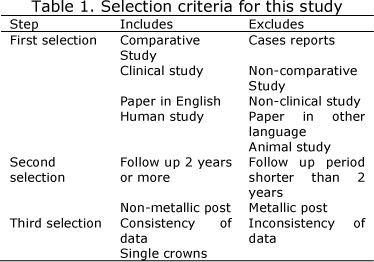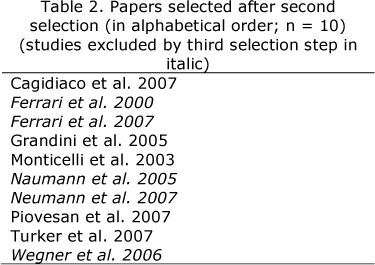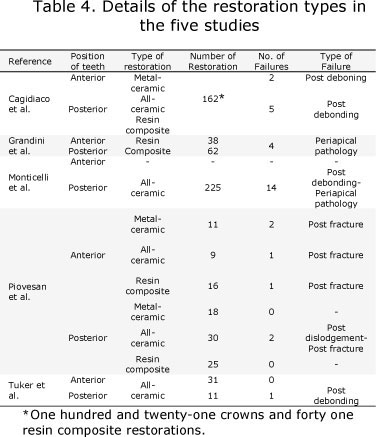Services on Demand
Article
Related links
Share
IJD. International Journal of Dentistry
On-line version ISSN 1806-146X
IJD, Int. j. dent. vol.9 n.2 Recife Apr./Jun. 2010
ORIGINAL ARTICLE ARTIGO ORIGINAL
Nonmetallic post-endodontic restorations: a systematic review
Restaurações a pino não metálicos pós endodontia: uma revisão sistemática
Matheus Coelho BandécaI; Omar El-MowafyII; Amr SheblIII; Sizenando de Toledo Porto-NetoIV
IPhD student in the Department of Restorative Dentistry, Faculty of Dentistry, University of Sao Paulo State and a research associate in the Department of Clinical Dental Sciences, Faculty of Dentistry, University of Toronto
IIProfessor of Restorative Dentistry in the Department of Clinical Dental Sciences, Faculty of Dentistry, University of Toronto
IIIAssistant lecturer in the Crown and Bridge Department, Faculty of Dentistry, Suez-Canal University and a research associate in the Department of Clinical Dental Sciences, Faculty of Dentistry, University of Toronto
IVAsso date professor in Department of Restorative Dentistry, Faculty of Dentistry, University of Sao Paulo State
ABSTRACT
To test the hypothesis that the placement of nonmetallic post in endodontically treated teeth is associated with improved survival rate of the restored teeth, using a systematic reviewing process of clinical studies. Papers referring to post-endodontic on restorative teeth were located by MEDLINE search with limitation of search to the first selection criteria. Study selection: A three-step inclusion-exclusion procedure was applied to identify papers that represented; comparative study, clinical study, papers in English, human study, restorations for more than 2 years of follow-up, restorations with non-metallic post with single crown and those with consistency of data. Application of the third selection resulted in five studies in which, 638 restorations were done and resulted in survival rates that ranged from 96% at 2 years to 94% at 8 years.
Key words: Dental materials; Post and core technique; Dental restoration failures.
RESUMO
Para testar a hipótese de que a colocação de núcleos não metálicos em dentes tratados endodonticamente está associado a taxa de sobrevivência dos dentes restaurados, utilizou-se um processo de revisão sistemática dos estudos clínicos. Artigos referentes a colocação de pinos para restauração dos dentes foram localizados por busca no MEDLINE com limitação da pesquisa para os critérios de seleção primeiramente. Estudo de seleção: um procedimento de três passos de inclusão-exclusã foi aplicado para identificar artigos; estudo comparativo, estudo clínico, artigos em inglês, estudos em humanos, restaurações com mais de 2 anos de acompanhamento, restaurações com pinos não metálicos com única coroa e aqueles com consistência dos dados. A aplicação da terceira seleção resultou em cinco estudos nos quais 638 restaurações foram realizadas e resultaram em um taxa de sobrevivência que variou de 96% aos 2 anos para 94% aos 8 anos.
Palavras-chave: Materiais dentários; Técnica do pino e núcleo; Falhas em restaurações dentárias
INTRODUCTION
Posts are generally indicated for restoring endodontically treated teeth that are highly suscepttble to fracture because of their insufficient coronal tooth structure1-3. Prefabricated posts were traditionally made of metal and might be visible through the structure of endodontically treated teeth, particularly in anterior region4. Also, they might have different degrees of stiffness5,6. Nonmetallic posts are made either from a resin matrix reinforced with carbon, glass or quartz fibers7or from ceramic materials8. With the exception of carbon posts, these posts showed more favorable esthetics in anterior teeth when restored with all-ceramic crowns due to their light-transmitting capacity in addition to their modulus of elasticity values that are similar to that of dentine7 and this can reduce the risk of tooth fractures and in turn can increase their survival rates when compared to teeth res tored with metallic posts 9 . Als o, these posts are able to form a monoblock structure created by dentin, resin cement and post4.
The systematic reviewing process enables the aggregation of res ults from different studies comparing different types of posts and aims to provide the current best available evidence upon which clinical decisions regarding the selection of endodontic posts can be based.
The objective of this study was to test the hypothesis that the placement of nonmetallic post in endodontically treated teeth is associated with improved survival rate of the restored teeth, using a systematic reviewing process of clinical studies.
MATERIAL AND METHODS
The literature search was conducted using a PubMed database search in the liberary of the faculty of dentistry-University of Toronto. The Search involved the years from 1971. Keywords were "post" and "endodontic". Abstract texts were not included and the search was limited by "language", "type of article" and "clinical study" showed in table 1. The second selection excluded papers with follow up periods shorter than 2 years" and those used "metallic post". A third step in the selection procedure was carried out to assess the quality of the papers. Studies that had no cons istency of data were excluded. The assessment of the quality of papers was necessary to obtain standardization for this systematic reviewing.

RESULTS
The first selection revealed 157 studies. The second selection revealed 10 papers that are shown in Table 27,10-18. In the third selection process, one study was excluded for using metallic posts and two were excluded due to lack of consistency of data. Another two studies were excluded due to the use of bridges rather than single crown restorations. The 5 papers that survive after the third selection are shown in Table 3 (presented in italics).

Cagidiaco et al.10 reported the clinical performance of fiber post restorations in endodontícally treated teeth. Two operators treated a total of 150 patents between February and July/ 2003 at the Department of Restorative Dentist ry of the University of Siena. The age of patients ranged from 18 to 75 years (mean: 56 years). Among the teeth included in the s tudy 35.2% of them were anterior teeth and 64.8% were posterior teeth. The teeth were previous ly endodontícaNy treated and the roots were prepared to receive posts. The quartz fiber posts (DT light post) were used and after the root canal spaces were prepared to a length of 8 mm according to the manufacturer. The us ed cement was Calibra resin cement (Dentsply Caulk) combined with Prime & Bond NT adhesive system (Dents ply Caulk) and the cementation procedure was performed according to the manufacturers ' instructions. Crowns and direct resin composite restorations were placed in 74.7% and 25.3% of the teeth respectively. During the follow-up periods (23 to 25 months), only 7.4% of the cases showed failure. The failure mode in 4.3%of the failed cases was post debonding occurred in crown-restored teeth where the others 3.1% of cases had periapical pathology. Debonding occurred in anterior teeth and in 3 posterior teeth where the restored teeth had no remaining coronal walls prior to treatment.
Grandini et al.12 conducted a clinical evaluation of the use of fiber posts and direct resin composites for restoring root-treated teeth. Eighty-one patients were treated in three private dental offices between January and February 2002. A total of 90 teeth were restored, 42.1% of the teeth were anterior teeth and 68.9% of them were posterior teeth. The mean age of the patients was 35.17 years (range, 15 to 56 years ). All teeth were endodontically treated and the root canal s paces were prepared to a length of 9 to 10 mm. The Duollnk resin cement (Bisco) was used for cementation of quartz fiber posts (DT light post , RTD). The restorative procedure was completed with direct resin composites . After 30 months, only 4 teeth exhibited periapical lesions and in 1 cas e, retreatment was performed without replacing the direct restoration. Five teeth showed a partial loss of the restoration. Six teeth exhibited slight marginal staining. After 2 years of clinical service, 4 teeth showed slight discoloration without the need of restoration replacement and eight teeth showed surface staining.
Monticelli et al.13 conducted a 2-year retrospective study of fiber posts. Two hundred twenty-five patents were treated in the Department of Restorative Dentistry, University of Sena. The mean age of the patients was 51 years (range, 18 to 78 years). This treatment was planned for premolars that presented with only two coronal walls left and only one post was placed in each premolar. The root spaces were created about 9 mm deep. Seventy-five patents received Aesthetic Plus posts (RTD), 75 patients received DT light posts (RTD) and others 75 patients received Postec posts (Ivoclar-Vivadent). Aesthettc Plus posts and DT light Posts were cemented with Duo-link resin cement (BISCO) combined with One-Step bonding system and Pos tec pos ts were cemented with Excite DSC adhesive and Multilink resin cement (Ivoclar-Vivadent). Cementation procedures were done following the manufacturer's instructions . All teeth were covered with porcelain-crowns. Follow-up was for 24 months and s howed only 6.2% failures, similarly distributed among the three post groups tested. Eight restorations failed due to post debonding (3.5%). Six restorations (2.7%) were failed due to the recurrence of periapical pathology.
Another prospective study was done by Piovesan et al.16 to evaluate polyethylene fiber-reinforced posts and cores used in endodontically treated teeth. Sixty-nine patients from a private dental office were studied. The age of patents were not reported by authors. One operator placed al 109 post-and-core restorations. 33% of the restored teeth were anterior teeth and 57% were posterior teeth. The root spaces were prepared for a length of 7 to 10 mm depending of tooth. A 2 mm-wide ultrahigh-molecular-weight polyethylene fibers (Ribbeond, Ribbond Inc) were used. The posts were cemented with Enforce (Dentsply Caulk). Teeth received ceramic-fused-to-metal crowns, all-ceramic crowns, or direct resin composite restoration. The mean follow-up period was 90.2 months. Failures of anterior teeth occurred twice in metal-ceramic crowned, 1 in all-ceramic crowned andl in resin composite restored teeth and the cause of failure was post fracture. For posterior teeth, failure occurred in 2 all-ceramic crowned teeth due to post dislodgement and pos t fracture.
Turker et al.17 conducted a pros pective clinical s tudy to evaluate ribbon-reinforced polyethylene fiber post. A total of 28 patients were treated during 5 years period and the mean age was 34.53 years. 73.8% of the restored teeth used in this study were anterior teeth and 25.2% were posterior teeth. The teeth were treated with 3-mm-wide polyethylene fiber ribbon (Connect Reinforcement Ribbon, Kerr Corp). Resin cement was us ed for luting the polyethylene fiber ribbon-reinforced posts. Syntac Primer, Syntac Adhesive and Helio Bond (Ivoclar Vivadent) were applied ac cording to manufacturers' instructions. Teeth were covered with Empress II all-ceramic crowns (Ivoclar Vivadent) that were cemented with resin cement. The follow-up periods were 10 to 73 months. Only 1 post dislodgement due to debonding was obs erved after 11 months of clinical use.
DISCUSSION
The results of the five clinical studies10,12,13,15,17 showed that nonmetallic posts lasted for 5 years so some overall conclusions can be drawn out about the performance and longevity of nonmetallic posts. Among the teeth included in theses studies 25.4% of them were anterior teeth and 74.5% of them were posterior teeth. The survival rates ranged from 96% at 2 years to 94% at 8 years. The majority of failures were due to post debonding. Almost all of the debondings occurred in cases where posts were bonded to teeth with less than 2 mm of dentin structure left at the coronal level10,13. In addition, debonding of the posts might be caused by difficulty of retention of the posts to intraradicular dentin19-21. Also, failure of the fiber nonmetallic posts was not associated with root fractures. Post fracture occurred in six teeth, 4 of them were anterior teeth and 2 were posterior teeth. Two of the anterior teeth were restored with metal crowns, one with all-ceramic and one tooth was restored with resin composite restoration. For posterior teeth, two teeth were restored with All-Ceramic crowns. In all cases, the polyethylene fiber-reinforced posts were used. Post dislodgment was observed in only 1 case after 11 months follow-up. The use of non-metallic post is commonly reparable when the post fracture occurred13,14,22-24.
The posts used in these studies were 52.5% quartz fiber posts, 13.2% glass fiber posts, 13.2% fiber-reinforced composite posts and 21.1% Polyethylene ribbon posts. The follow-up period was up to 7 years. Comparing the posts failures separately, 5% of failures occurred in quartz fiber posts, 8% in fiberglass posts, 5.3% in fiber-reinforced composite posts and 5.8% in polyethylene ribbon post (Figure 1).

Standlee et al.25 reported that the cement layer may contribute to uniform stress distribution between post and the root canal. Mendonza et al.26 evaluated the ability of resin-bonded posts to reinforce teeth and concluded that resin cements rendered the teeth more res istant to fracture than when zinc phosphate was used.
All posts in these five studies were cemented with resin cements. 456 teeth were restored with crowns and 182 were restored with direct resin composite restorations. The table 4 shows the details of restorations used in the five studies10,12,13,16,17. In these five studies it was not possible to evaluate the quantity of failures in crowns and direct resin composite restorations separately.

CONCLUSIONS
According to the reports of 5 studies, the hypothes is that the placement of nonmetallic posts in endodontically treated teeth is associated with improving the survival rates of restored teeth was confirmed through this systematic reviewing. The survival rates ranged from 96% at 2 years to 94% at 8 years.
REFERENCES
1. Sorensen JA, Marttnoff JT. Intracoronal reinforcement and coronal coverage: a study of endodontically treated teeth. J Prosthet Dent 1984; 51:780-784. [ Links ]
2. Assif D, Gorfil C. Biomechanical considerations in restoring endodontically treated teeth. J Prosthet Dent 1994; 71:565-567. [ Links ]
3. Morgano SM. Restoration of pulpless teeth: application of traditional principles in present and future contexts. J Prosthet Dent 1996; 75:375-380. [ Links ]
4. Abo El-Ela OA, Atta OA, El-Mowafy O. Fracture resistance of anterior teeth restored with a novel nonmetallic post. J Can Dent Assoc 2008; 74:441-441e. [ Links ]
5. Akkayan B, Gülmez T. Resistance to fracture of endodontically treated teeth restored with different post systems. J Prosthet Dent 2002; 87:431-437. [ Links ]
6. Fredrikss on M, Astback J, Pamenius M, Arvidson K. A retrospective study of 236 patients with teeth restored by carbon fiber-reinforced epoxy resin posts. J Prosthet Dent 1998; 80; 151-157. [ Links ]
7. Ferrari M, Vichi A, Mannocci F, Mason PN. Retrospective study of the clinical performance of fiber posts. Am J Dent 2000; 13:9B-13B. [ Links ]
8. Koutayas SO, Kern M. All-ceramic posts and cores: the state of the art. Quintessence Int 1999; 30:383-392. [ Links ]
9. Manocci F, Ferrari M, Watson TF. Intermittent loading of teeth restored using quartz fiber, carbon-quartz fiber, and zirconium dioxide ceramic root canal posts. J Adhe s Dent 1999; 1:153-158. [ Links ]
10. Cagidiaco MC, Radovic I, Simonetti M, Tay F, Ferrari M. Clinical performance of fiber post restorations in endodontically treated teeth: 2-Year results. Int J Prosthodont 2007; 20:293-298. [ Links ]
11. Ferrari M, Cagidiaco MC, Goracci C, Vichi A, Mason PN, Radovic I, Tay F. Long-term retrospective study of the clinical performance of fiber posts. Am J Dent 2007; 20:287-291. [ Links ]
12. Grandini S, Goracci C, Tay F, Grandini R, Ferrari M. Clinical evaluation of the use of fiber posts and direct resin restorations for endodontically treated teeth. Int J Prosthodont 2007; 18:399-404. [ Links ]
13. Monticelli F, Grandini S, Goracci C, Ferrari M. Clinical behavior of translucent-fiber posts: A 2-year prospective study. Int J Prosthodont 2003; 16:593-596. [ Links ]
14. Neumann M, Blankenstein F, Kessling S, Dietrich T. Risk factors for failure of glass fiber-reinforced composite post restorations: a prospective observational clinical study. Eur J Oral Sci 2005; 113:519-524. [ Links ]
15. Neumann M, Sterzenbach G, Franke A, Dietrich T. Randomized controlled clinical pilot trial of titanium vs glass fiber prefabricated posts: preliminary results after up to 3 years. Int J Prosthodont 2007; 20:499-503. [ Links ]
16. Piovesan EM, Demarco FF, Cenci MS, Pereira-Cenci T. Survival rates of endodontically treated teeth restored with fiber-reinforced custom posts and cores: A 97-month study. Int J Prosthodont 2007; 20:633639. [ Links ]
17. Turker SB, Alkumru HN, Evren B. Prospective clinical trial of polyethylene fiber ribbon-reinforced, resin composite post-core buildup restorations. Int J Prosthodont 2007; 20:55-56. [ Links ]
18. Wegner PK, Freitag S, Kern M. Survival rate of endodontically treated teeth with posts after prosthetic restoration. J Endod 2006; 32:928-931. [ Links ]
19. Ferrari M, Mannocci F, Vchi A, Cagidiaco MC, Major IA. Bonding to root canal: Structural characteristics of the substrate. Am J Dent 2000; 13:255-260. [ Links ]
20. Mjör IA, Nordahl I. The density and branching of dentinal tubules in human teeth. Arch Oral Biol 1996; 41:401-412. [ Links ]
21. Chersoni S, Acquaviva GL, Prati C, Ferrari M, Grandini S, Pashley DH, Tay FR. In vivo fluid movement through dentin adhesives in endodontically treated teeth. J Dent Res 2005; 84:223-227. [ Links ]
22. Sorrentino R, Monticelli F, Goracci , Zarone F, Tay FR, Garca-Godoy F, Ferrari M. Effect of post retained composite restorations and the amount of coronal re sidual structure on the fracture resistance of endodontkally-treated teeth. Am J Dent 2007; 20:259274. [ Links ]
23. Malferrari S, Monaco C, Scotti R. Clinical evaluation of teeth restored with quartz fiber-reinforced epoxy resin posts. Int J Prosthodont 2003; 15:39-44. [ Links ]
24. Newman MP, Yaman P, Dennison J, Rafter M, Biily E. Fracture resistance of endodontically treated teeth restored with composite posts. J Prosthet Dent 2003; 89:350-357. [ Links ]
25. Standlee JP, Caputo AA, Collard EW, Pollack MH. Analysis of stress distribution by endodontic posts. Oral Surg Oral Med Oral Pathol 1972; 33(5): 952-950. [ Links ]
25. Mendoza DB, Eakle WS, Kahl EA, Ho R. Root reinforcement with a resin-bonded preformed post. J Prosthet Dent 1997; 78: 10-14. [ Links ]
 Correspondence:
Correspondence:
Matheus Coelho Bandeca
matheus.bandeca@utoronto.ca
Recebido em 30/01/2010
Aprovado em 25/04/2010













